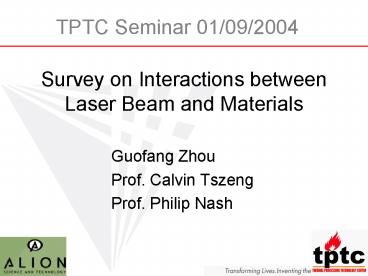Survey on Interactions between Laser Beam and Materials - PowerPoint PPT Presentation
1 / 14
Title:
Survey on Interactions between Laser Beam and Materials
Description:
When the depth and width of the surface roughness are much larger than the laser ... If surface plasmon energy is known. If electron concentration is known ... – PowerPoint PPT presentation
Number of Views:33
Avg rating:3.0/5.0
Title: Survey on Interactions between Laser Beam and Materials
1
Survey on Interactions between Laser Beam and
Materials
TPTC Seminar 01/09/2004
- Guofang Zhou
- Prof. Calvin Tszeng
- Prof. Philip Nash
2
Interaction of Electromagnetic Radiation with
Material
3
Parameters Determining the Nature of the
Interaction
- Energy density of the laser beam
- Wavelength of the laser
- Optical properties of the material
- Surface condition
- Surface roughness
- Oxidation
- Coating
4
Surface Roughness
- When the depth and width of the surface roughness
are much larger than the laser wavelength, it
causes multiple reflections and multiple
absorptions of laser light which may enhance the
absorption by an order of magnitude over that on
a perfectly flat surface.
Simplified Rectangular Well Model of the Surface
Roughness (Ang 1997)
5
Estimate of the Absorption Coefficient in Single
Reflection
S Polarization
Incident angel Electron plasma frequency Frequency
of the light wave Electrical conductivity of the
target metal
- L.K. Ang etc. Appl. Phys. Letter 70 (6) 10
February 1997 pp. 696-698
6
Estimate of the Absorption Coefficient in Single
Reflection
Determination of Electron Plasma Frequency
- If surface plasmon energy is known
- If electron concentration is known
- For pure aluminum with a series of KrF excimer
laser pulses (wave length 248 nm, 40 ns, power
density 6.4 J/cm2), the absorption coefficient
is 0.84.
C. Kittel, Introduction to Solid State Physics
(Wiley, New York, 1996)
7
Cumulative Absorption Coefficient vs. Surface
Roughness
8
Absorption vs. Temperature
Wave length 690 nm Sample Silver
A. M. Bonch-Bruevish, etc. Sov. Phys. Tech.
Phys. 13. 640 (1968)
9
Surface Oxidation
- 360 W CO2 Laser
- Wave length 10.6 um
- Cold Rolled AISI 1010
- Thickness 0.6 mm
- Incident angle 15 deg
J. Xie etc. Welding Research Supplement Oct.
1999 pp. 343-348
10
Experimental and Theoretical Values of
Reflectivity at for CO2 (Wave Length10.6 µm)
- All samples were polished.
- Some claimed that the reflectivity will be close
to zero after melting
J. Xie etc. Welding Research Supplement Oct.
1999 pp. 343-348
11
Estimation of Absorption Coefficient of Diode
Laser on Al
- Wave Length 808 nm
Angs Model
Absorption coefficient is 0.746
Larger wavelength, lower absorption coefficient
12
Estimation of Absorption Coefficient of Diode
Laser on Fe
Using the same diode laser and Angs model
Electron plasma frequency for iron is unknown
which can be calculated by electron concentration
from
free space permittivity n electron
concentration e electron charge m mass of
electron
13
Estimation of Absorption Coefficient of Diode
Laser on Fe
Calculation of free electron concentration
- Iron
- Atomic number 26
- Number of free electron is 2
- BCC structure, each cell has 2 atoms
- Lattice parameter is 2.87 Angstrom
So free electron concentration of BCC Fe is
1.691029 m-3
14
Estimation of Absorption Coefficient of Diode
Laser on Fe
2.3431016 rad/s
A 2.08































